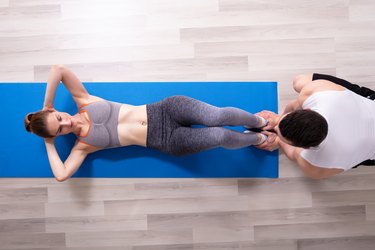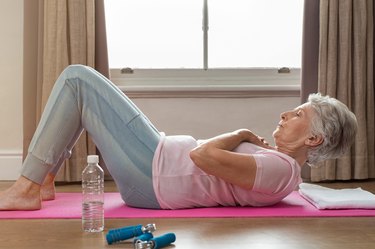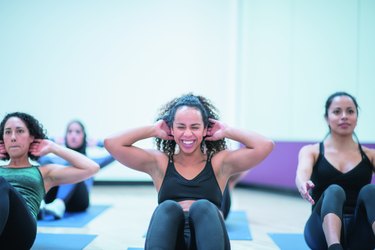
Strong abdominals sustain good posture, protect against injury and prevent pain in your lower back. And doing sit-ups and crunches might just help you get there.
While the two exercises seem quite similar, there are a few differences between the muscles they work. Both are done lying on the floor with your knees bent and your hands behind your head. With crunches, your lower back doesn't lift off the ground, whereas in a sit-up, your whole torso rises.
Video of the Day
Here, Mariashi Bennett, CPT, a certified personal trainer and weightlifter, explains how to perform each exercise, the differences between the two and when to do each.
How to Do a Sit-Up With Proper Form
- Lie on your back with bent knees and your heels on the ground, toes pointing up toward the ceiling.
- Don’t keep your feet too close to your glutes. Move them out until your knees are at about a 45-degree angle, depending on what's most comfortable for you.
- Position your arms straight down by your sides, palms on the ground.
- Engage your core and lift your upper body off the ground as your raise all the way up to a sitting position.
- Focus on keeping your heels on the ground throughout the exercise.
- Once you are at the top, slowly lower yourself back down.
Sit-Ups Muscles Worked
Sit-ups work all of your core muscles, including your rectus abdominis (the large muscle in the front of your abdomen that extends from your ribs to the front of your pubic bone), obliques (the muscles on the sides of your abdomen) and transverse abdominis (the deepest layer of abdominal muscle).
However, sit-ups "primarily engage the rectus abdominis, which are the muscles that run vertically down the front of the abdomen, creating the six-pack," Bennett says.
Sit-ups also work your hip flexors, which run from your thighs to your lower back.
Benefits of Sit-Ups
1. They Build Core Strength
Because sit-ups have a broad range of motion, they're a comprehensive core exercise that can help strengthen your entire abdominal region, Bennett says. (Because of the full range of motion you go through during a sit-up, you may find sit-ups harder than crunches.)
A strong core can help reduce back pain, improve your posture and make daily physical activities a little easier, according to the Mayo Clinic.
2. They Help With Mobility
"Sit-ups are a functional exercise that can help you build strength for everyday activities that involve bending, twisting or lifting," Bennett says.
Because sit-ups work your abs, hip flexors and lower back, they can help strengthen those areas and relieve tightness, which both can help improve your mobility.
3. They Improve Your Posture
Sit-ups build core endurance, allowing you to maintain proper stability over long periods of time, Bennett says. And that means improved posture, as your abs and back muscles become stronger and better able to keep your body aligned.
How to Do a Crunch With Proper Form
- Lie on your back with bent knees and your heels on the ground, toes pointing up toward the ceiling.
- Don’t keep your feet too close to your glutes. Move them out until your knees are at about a 45-degree angle, depending on what's most comfortable for you.
- Position your arms straight down by your sides, palms on the ground.
- Engage your core and lift your head and shoulder blades off the ground. Your neck can curl slightly, but it shouldn't strain toward your chest.
- Focus on keeping your heels on the ground throughout the exercise.
- Once you are at the top, slowly lower yourself back down.
Crunches Muscles Worked
Crunches primarily engage your rectus abdominis and transversus abdominis, "which is like a natural corset," Bennett says. The transversus abdominis are the deep, flat muscles that stabilize your trunk and help maintain internal abdominal pressure, according to the Cleveland Clinic.
Crunches can also engage your obliques if you perform a twisting crunch variation, she says.
Benefits of Crunches
1. They Improve Ab Definition
If a visible six-pack is what you're after, adding crunches to your routine (as well as focusing on a nutritious diet for fat loss) may be the golden ticket.
"Being that crunches are a bit more isolated and focused on the rectus abdominis [than sit-ups], crunches are great for sculpting abdominal definition," Bennett says.
2. They're Not Stressful on Your Back
Crunches can help reduce lower back pain because they have a smaller range of motion than sit-ups do, Bennett says. "Crunches put less stress on the spine, but still allow you to work the abdominal muscles."
3. They Boost Muscle Endurance
"Performing crunches can also help you focus on your abdominal breathing, which will translate to other exercises and everyday life and activities," Bennett says.
Doing crunches just once a week showed to improve abdominal endurance in people who had never done ab exercises, per a small April 2015 study in the Journal of Sports Medicine and Physical Fitness.
Sit-Up vs. Crunch: When to Perform Each Exercise
Whether you choose to bang out some sit-ups or crunches depends on your fitness goals and preferences.
"Given sit-ups' fuller range of motion and more muscular engagement, they are better at developing overall core and functional strength," Bennett says. "Meanwhile, crunches are more focused on the rectus abdominis, helping you define the upper part of your abdominal muscles."
So if your goal is ab definition, do more crunches. But if you care about overall strength, prioritize sit-ups.
The Sit-Up vs. Crunch Bottom Line
So, which is better: crunches or sit-ups? Crunches are better for aesthetic purposes rather than function meanwhile sit-ups are better for building overall core strength, Bennett says.
Either way, you'll probably want to incorporate both into your workouts.
For ab exercises such as sit-ups and crunches, Bennett recommends 10 to 20 reps for three to four sets. The last few repetitions should find you at the end of your endurance.
You can increase the intensity of abdominal exercises by holding a weight near your chest (like a dumbbell or kettlebell), moving more slowly or performing the exercises on a slant board or exercise ball so your head is at a lower elevation than your legs.
Was this article helpful?
150 Characters Max
0/150
Thank you for sharing!
Thank you for your feedback!



